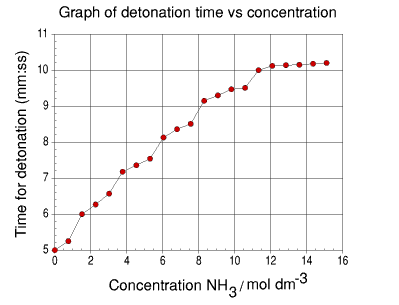The experiment was set up as described in Method 1.3.1 and the times for detonation recorded with concentration. The table (below) shows the %water, %ammonia, %w/v ammonia and the concentration of ammonia in the preparation solution and detonation time of the solid. 0.880 S.G. ammonia solution has a concentration of 15.1 molar7. The concentration in the table is for 100 cm3 solution.
7 Svehla, G. (Ed.) Vogel's Qualitative Inorganic Analysis, 6th Ed. p. 284. Longman 1987
| % water | % ammonia | % w/v ammonia | [NH3] | Det time (mm:ss) |
| 100.00 | 0.00 | 0.00 | 0.00 | 5.00 |
| 95.00 | 5.00 | 1.55 | 0.75 | 5.25 |
| 90.00 | 10.00 | 3.10 | 1.51 | 6.00 |
| 85.00 | 15.00 | 4.65 | 2.27 | 6.27 |
| 80.00 | 20.00 | 6.20 | 3.02 | 6.57 |
| 75.00 | 25.00 | 7.75 | 3.77 | 7.18 |
| 70.00 | 30.00 | 9.30 | 4.53 | 7.36 |
| 65.00 | 35.00 | 10.85 | 5.29 | 7.54 |
| 60.00 | 40.00 | 12.40 | 6.04 | 8.13 |
| 55.00 | 45.00 | 13.95 | 6.79 | 8.36 |
| 50.00 | 50.00 | 15.50 | 7.55 | 8.51 |
| 45.00 | 55.00 | 17.05 | 8.30 | 9.15 |
| 40.00 | 60.00 | 18.60 | 9.06 | 9.30 |
| 35.00 | 65.00 | 20.15 | 9.81 | 9.47 |
| 30.00 | 70.00 | 21.70 | 10.57 | 9.51 |
| 25.00 | 75.00 | 23.25 | 11.32 | 10.00 |
| 20.00 | 80.00 | 24.80 | 12.08 | 10.12 |
| 15.00 | 85.00 | 26.35 | 12.84 | 10.14 |
| 10.00 | 90.00 | 27.90 | 13.59 | 10.15 |
| 5.00 | 95.00 | 29.45 | 14.35 | 10.18 |
| 0.00 | 100.00 | 31.00 | 15.10 | 10.20 |

Graph for minimum ammonia required for stabilisation.
When the concentration of ammonia vs. detonation time was plotted, it can be seen that any concentration of ammonia greater than around 10.57 molar will give a stability which can be utilised as a storage medium. Concentrations of this level pose a lower hazard that the concentrated solution for both inhalation and skin contact. Stability for this experiment has been defined as stable for ten minutes or over.
Pages
- Theory
- Safety
- Theory
- Bomb Calorimetry
- NI3 & Agar
- Analytical techniques
- Chemical Safety
- Practical methodology
- Sound as a detonator
- Determination of ammonia
- Main results
- Method 1 Results
- Ammonia results
- Minimum ammonia results
- Bomb calorimetry results
- Gel times
- IR Results
- XRD Results
- UV Results
- Conversion to HTML
- Bibliography
- Further work
- Acknowledgements
- Technology Used